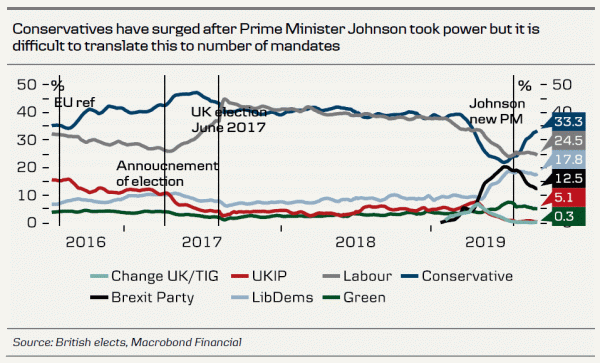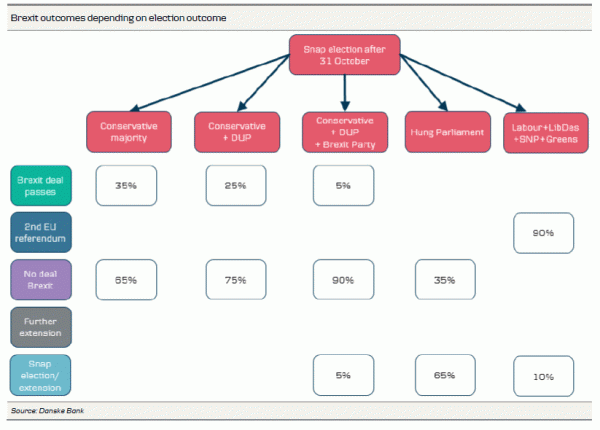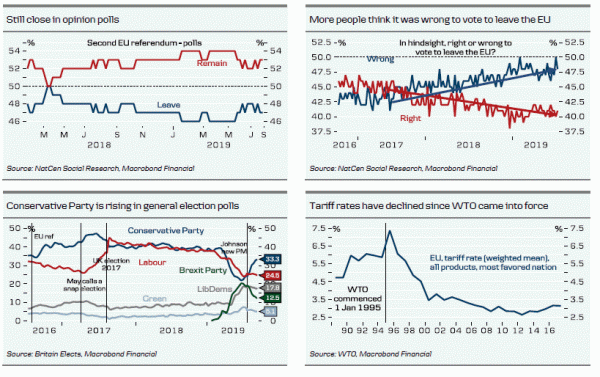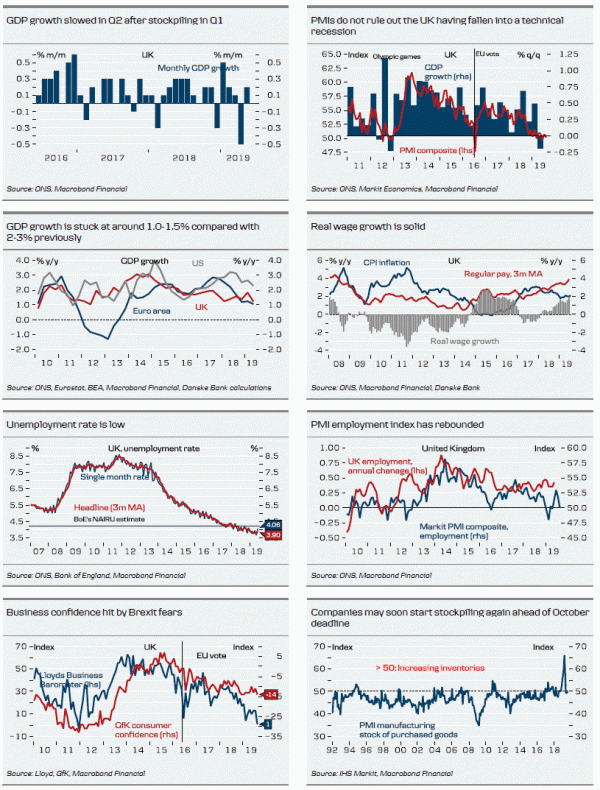Key takeaways
- Our base case is now that the UK will call a snap election early next week and that this will be held after 31 October (i.e. likely in November), implying an extension of the current Brexit deadline of 31 October into next year.
- While the election may not be called before mid-October, a snap election seems unavoidable and the election result will be important for the Brexit end game.
- In this piece, we analyse what to expect with respect to Brexit depending on the election outcome.
- Unfortunately, it is difficult to predict the outcome, as we cannot translate opinion polls directly into number of seats. Seat projections during the run-up to the 2017 election were a long way from the result.
- Due to the above, we do not have a strong view on the result right now but our gut feeling says we will end up with another Conservative government or a hung parliament.
- In any case, the election is going to be an EU referendum in disguise.
- If the Conservatives win, perhaps supported by the DUP and/or the The Brexit Party, our base case is a no-deal Brexit.
- If the Labour, Liberal Democrats, Scottish National Party (SNP) or Greens win a majority, it is likely, in our view, that we are heading for a second EU referendum. Opinion polls show remain is slightly ahead.
- If we have a hung parliament where the parties are unable to co-operate, we are likely heading for another extension and snap election.
Election day most likely after 31 October
A snap election seems unavoidable at this point. The question is whether Prime Minister Boris Johnson and Labour leader Jeremy Corbyn can reach an agreement on whether to hold the election before or after the Brexit deadline on 31 October. Johnson wants it before to avoid breaking his ‘do or die’ promise. Jeremy Corbyn wants it after to ensure the extension of the Brexit deadline. Remember if the election is not called for next week, Parliament will still be prorogued (‘suspended’/‘sent home’). This does not mean we will not get a snap election but it would be after 31 October.
In our view, the most likely scenario is an election is called early next week and will be held after the 31 October deadline (probably in November). This also means that we expect an extension of the Brexit deadline. This probably explains why the GBP has rallied lately, as the immediate threat of a no-deal Brexit in October has declined and a snap election opens the way for more GBP-positive scenarios.
Due to the two-thirds majority requirement under the Fixed Term Parliament Act, Corbyn has the strongest hand of him and Johnson. Corbyn would not be interested in an election before the extension of Brexit, because Johnson (assuming he wins) could then just repeal the delay bill and go for a no-deal Brexit. The question is whether Johnson is able one way or another to get out of being the one asking the EU for an extension. One way to do this could be for The Conservative Party to call for a no-confidence vote in its own government and hope some of the independents and/or SNP vote no confidence. This could pave the way for a caretaker Prime Minister to take care of the extension.
The Brexit delay bill suggests an extension to 31 January. While we expect EU leaders to accept an extension, it is not a given that the new date would be 31 January. The question is whether the EU wants a short, medium or long extension. The EU leaders, who are more ‘hawkish’ on Brexit, could still say no to the request but this seems far-fetched despite the Brexit fatigue. On several occasions, the EU system has said that a no-deal Brexit would be the UK’s decision. The Brexit delay bill says the UK Prime Minister must accept whatever length and terms of extension the EU wants. While we think a long extension would make most sense, we believe the extension is likely to be three to six months.
The Brexit delay bill also forces the government to inform the House of Commons on the progress of the Brexit negotiations, which gives the House of Commons the possibility of controlling the Brexit process.
Election result is now what matters
Our base case is an election after 31 October (probably in November) but disregarding the election date, the election result will to be important for Brexit. Unfortunately, it is difficult to translate polls into mandates due to the ‘winner takes all’ election system (see appendix for more details). Just to illustrate, the Conservatives won 13 seats in Scotland in the 2017 election but it seems likely to us that it would be difficult for Johnson to win more than a few Scottish seats in an election now.
The seat projections were way off in 2017 (see Institute for Government) except for the YouGov election model, which is the only one that signalled the Conservatives would lose the absolute majority. The latest update was in February and we should not expect more regular updates of the model before an election is called. The problem last time was that the turnout was higher than expected (68.8% versus 66.2% in 2015) and the highest since 1997. Currently, most seat projections point to an absolute majority for the Conservatives but one should not put too much weight on these
The Conservative Party’s support has surged (at the expense of The Brexit Party) since Boris Johnson took over as Prime Minister, as Boris Johnson has turned the party toward a harder Brexit stance. Still, this does not mean the Conservatives would win an absolute majority, as explained above.
In our view, a general election would be an EU referendum in disguise. Boris Johnson has already pledged to campaign on his ‘do or die’ approach saying that it is Parliament’s fault that Brexit is not being delivered by 31 October as promised. He says he will deliver Brexit ‘do or die’ repeatedly. Labour, Liberal Democrats, SNP and Greens are likely to campaign for a second EU referendum. This means we may soon get to the Brexit end game, unless we get a (very) hung parliament without a clear majority. If this is the case, the period of high uncertainty and confusion will continue.
In the following, we discuss what we consider to be the five most likely election results and what they mean in terms of Brexit based on the assumption an election takes place after 31 October, probably in November.
Scenario 1: Conservatives win solid absolute majority
A solid majority win for the Conservatives would get us closer to a Brexit end game, in our view. Even a slim majority may also prove sufficient, as long as Johnson achieves independence from the DUP and Brexit Party.
Prime Minister Johnson would become more powerful, as winning elections is what politics is all about. At the same time, some of the moderate Conservatives working against a nodeal Brexit would be replaced by more pro-Brexit and loyal politicians. Both pull in the direction of making no-deal Brexit more likely, as it remains complicated to find an alternative to the current Brexit deal (or backstop) that satisfies everyone. The EU revealed this week that there has not been progress in the Brexit talks, as the UK has not sent any proposals for alternatives to the backstop, despite the UK government saying it would. A strong Johnson government may not change strategy just because the Brexit deadline is extended into 2020. We attach a 65% probability of a no-deal Brexit in this scenario. A solid win for Boris Johnson may be exactly what is needed for the EU to blink and the two sides to reach a new agreement. It would also be easier for Prime Minister Johnson to pass a deal in Parliament, even if such a deal does not completely satisfy all eurosceptics, as he would be more powerful. In addition, Prime Minister Johnson would not need to rely on votes from the current supporting party DUP. One solution could be a Northern Ireland only backstop (perhaps a watered down version). Labour Brexiteers may also be more inclined to vote in favour to avoid a no-deal Brexit in this scenario. We attach a 35% probability of a Brexit deal passing in this scenario.
Looking beyond Brexit, focus would turn to Johnson’s economic policy, where he has pledged to lower taxes and increase spending. We do not know many details yet but based on what we do know, it may be a significant fiscal boost to growth (and, we hope, productivity growth down the road, depending on what Johnson spends the money on). We also see a high risk of a second independence referendum in Scotland in coming years and further out perhaps even a unification referendum in Northern Ireland.
Scenario 2: Conservatives win a majority together with DUP
We could end up with the same result as in the 2017 general election, with the Conservatives governing supported by the DUP. In this scenario, the likelihood of a nodeal Brexit is probably slightly higher than in Scenario 1, as Prime Minister Johnson would be unable to pass a Brexit deal with a Northern Ireland only backstop. We attach a 75% probability to no deal and 25% to a Brexit deal passing
Scenario 3: Conservatives win majority together with DUP and
The Brexit Party
In this scenario, we think there is a very high likelihood of a no-deal Brexit, perhaps around 90%, as The Brexit Party would not vote in favour of a deal of any kind. It is very difficult to see a way out of a no-deal Brexit in this scenario, unless some loyal Conservative MPs turn into rebels but this is hard to imagine now following the recent expulsions. Otherwise, the Conservatives and Labour need to make a cross-party agreement, which also seems doubtful.
The scenario does not seem very likely though, as the Conservatives and The Brexit Party are talking to the same voter base. There are likely to be many wasted votes on The Brexit Party, just like the UKIP experienced in 2015, when it won only one mandate despite getting 13% of the national vote.
Scenario 4: (Very) hung parliament
We may end up with a (very) hung parliament without a clear majority for any party or coalition of parties (or the parties refuse to, or are unable to, work together in coalitions). In this scenario, it is difficult to predict what would happen. We may very well get a further extension down the road but this depends on whether there is still an anti-‘no-deal Brexit’ majority. This may not be the case now the Conservative Party has moved in a hard Brexit direction. A snap election also seems likely but this may not change anything if voters do not shift. One of the major problems about Brexit is that there is no majority for anything, neither among the MPs nor the voters. A further extension and general election is 65% likely.
Uncertainty remains high without a clear majority and the risk of a no-deal Brexit happening by accident increases. The no-deal Brexit probability is likely to be around 35%.
Without a strong government, it is difficult to see how there can be any serious negotiations with the EU (also because the EU would not know whether any deal could pass in the House of Commons). Therefore, the likelihood of a deal passing is probably very low in this scenario.
Scenario 5: Labour + Liberal Democrats + SNP + Greens win the majority
While it would not be easy for the four parties to co-operate, the parties are more pro-EU and have indicated they want a second EU referendum with remain as an option. Labour is most sceptical, as it wants to negotiate its own Brexit deal first, which should be included on the ballot paper. Whether this will be the case depends on the strength of the individual parties. The stronger the Liberal Democrats are, the higher the likelihood of a second EU referendum.
We think a second EU referendum with remain as an option is almost certain in this scenario, perhaps with a probability of something like 90%. Looking at recent EU referendum polls, ‘remain’ is still slightly ahead but it is a close call, not least taking into account that polls were at least somewhat biased towards ‘remain’. The difficult question is what alternative to ‘remain’ appears on the ballot paper. Following an EU referendum, it is difficult to see such a coalition being able to survive and we may head for a general election.
In our view, it is highly unlikely Labour will get an absolute majority by itself, not least because the Labour Party is polling badly in Scotland.
Appendix: UK election system
Each of the 650 constituencies elects one Member of Parliament by the so-called ‘first past the post’ system, where the candidate with most votes (not necessarily the majority of the votes) takes the seat (‘winner takes all’). This election system benefits the big parties and explains why The Conservative Party and The Labour Party have taken turns leading the government. This has been breaking up more recently with hung parliaments (i.e. no party with absolute majority by itself) following the 2017 and 2010 elections. The ‘winner takes all’ system also means there is a higher degree of tactical voting, as there is a high risk of a wasted vote. If Party A gets 30%, Party B gets 30% and Party C gets 40%, then the candidate from Party C wins the seat. However, if Party B’s voters vote for Party A instead, Party A wins the mandate. This explains why the Scottish National Party (SNP) has many MPs, while its share of the national vote is small.
The magic number for a majority is 326 seats but in practice the number is a little lower, as historically the seven Sinn Fein (the Irish republican party) MPs have not taken their seats. The number of mandates for Sinn Fein changes from election to election.
The Fixed Term Parliament Act of 2011 introduced fixed-term elections with an election every fifth year with two exceptions (1) the House of Commons dissolves itself by a twothirds majority or (2) the government loses a no-confidence vote and no new government is formed within two weeks.
A person is eligible to vote only if he/she is a registered voter, which usually explains why historically the turnout among young voters has been low. Polling stations are open from 08:00 CET/CEST to 23:00 CET/CEST. Exit polls are released when polling stations are closed. We usually know the election results early in the morning of the following day
























